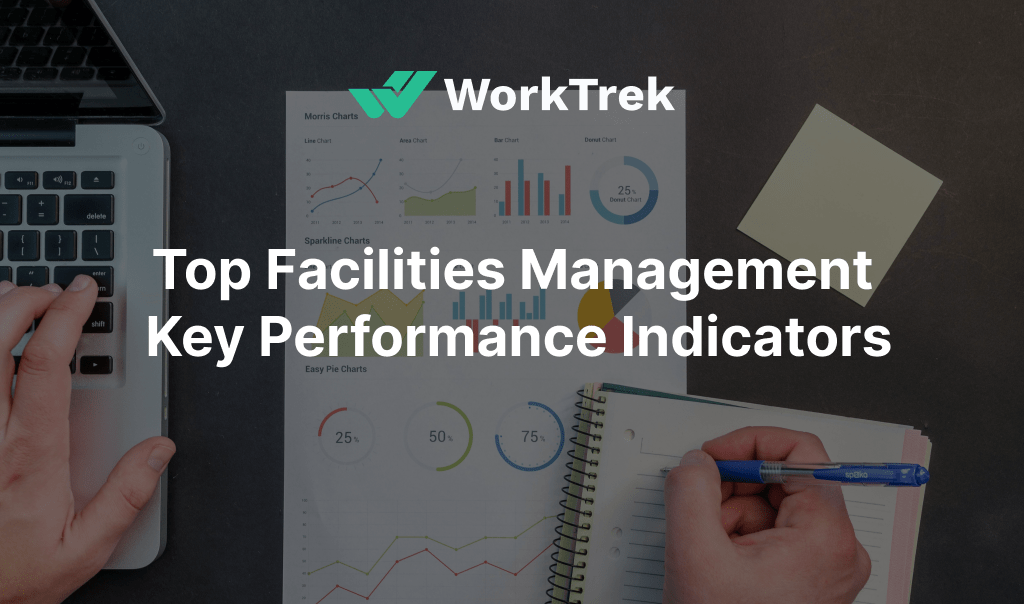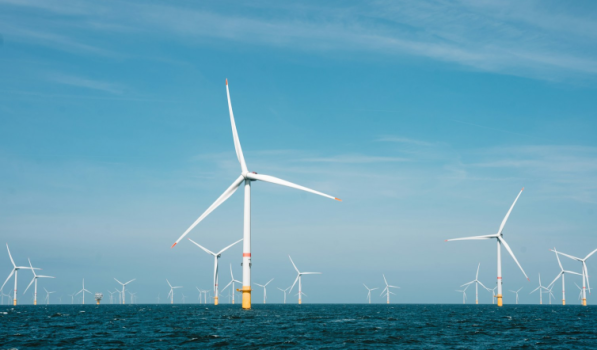Get a Free WorkTrek Demo
Let's show you how WorkTrek can help you optimize your maintenance operation.
Try for freeSorting through the multitude of facilities management key performance indicators can be challenging. KPIs are vital for evaluating and improving your facility’s performance. Facilities Management KPIs are critical for benchmarking maintenance activities and aligning them with broader business objectives, and they should be tailored to fit each organization’s specific industry and goals.
Essential Facilities Management KPIs include Overall Equipment Effectiveness (OEE), Planned Maintenance Percentage (PMP), Asset Reliability, and Cost Control Metrics, which drive operational excellence and resource efficiency.
This article summarizes the critical KPIs, dissecting how each functions to streamline operations and sharpen your management acumen. Explore how to identify, analyze, and implement the KPIs to establish the benchmark for your facilities’ success.
Understanding Facilities Management KPIs
Key performance indicators (KPIs) in facilities management go beyond mere statistics. They measure how maintenance activities contribute to your business’s broader objectives.
These KPIs reveal insights into operational efficiency, environmental sustainability, and safety by interpreting what numbers mean within the context of organizational aims and the dedication of your maintenance team.
It can help the organization measure progress, predict future performance, reduce average time to repair, and reduce unexpected failures.
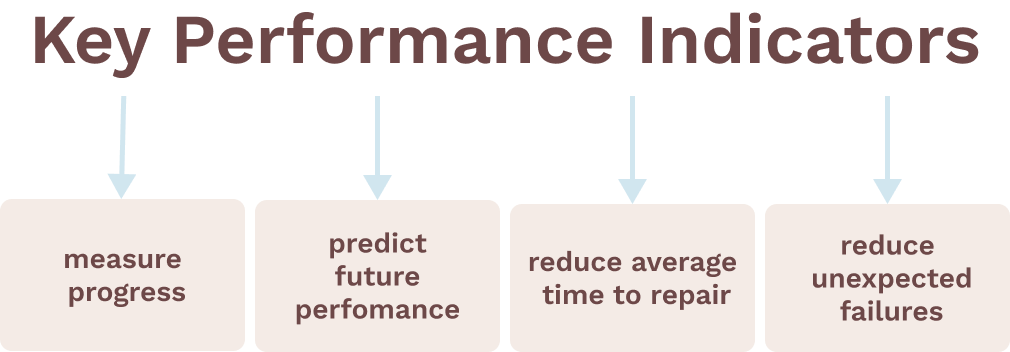
Source: WorkTrek
Maintenance Performance Metrics
Maintenance performance metrics provide insights into the effectiveness of the maintenance team and systems operations, quantifying daily maintenance activities compared to target numbers. These numbers can include the following:
- Mean Time to Repair
- Total Maintenance Costs
- Maintenance Overtime
- Asset Failure
- Visibility to Labor Costs
- Improved Machine Reliability
- Reduce time to repair (MTTR)
Navigate KPIs
Maintenance managers leverage these performance metrics as navigational tools for making informed decisions that correlate with established benchmarks for upkeep efficacy. With the data gathered, maintenance managers can use KPIs to guide decision-making processes within the maintenance department toward asset reliability or regulatory adherence.
The selection process for these KPIs must be tailored to reflect each industry’s distinctive needs and company ambitions.
This indicates that no universal template applies to all scenarios when adopting appropriate key performance indicators for tracking maintenance excellence.
Essential KPIs for Effective Facility Oversight
Key performance indicators (KPIs) are vital for operational excellence in facility management and can provide valuable insights. They can act as specific, quantifiable benchmarks for monitoring maintenance targets and advancements, underscoring their importance in refining maintenance processes and fulfilling broader organizational goals.
We’ll examine the indicative and driving metrics of efficient oversight, such as overall equipment effectiveness (OEE), planned maintenance percentage (PMP), and asset reliability. Each plays a fundamental role in establishing strong facility management practices, reducing unplanned downtime, and allowing maintenance managers to implement continuous improvement.
Asset Uptime and Availability
The health of a facility’s operations is determined mainly by the uptime and availability of its assets. When these assets function without interruptions, your facility can achieve maximum productivity. There’s more to it than simply having the equipment operational.
Monitoring how often equipment downtime occurs provides critical insights into the efficacy of maintenance strategies deployed within a facility. This aspect is deeply connected with overall equipment effectiveness (OEE), offering an extensive view of how productive your establishment is.
Conversely, minimizing or avoiding downtime directly impacts optimal performance levels in any operation. It sets off a chain reaction whereby each instance of machinery not operating as expected disrupts the workflow and escalates operational expenses.
To tackle this issue effectively, maintenance teams focus on minimizing unplanned downtimes by tracking metrics and implementing a preventive maintenance plan. This includes turning unexpected malfunctions into scheduled opportunities for improvement.
This approach enhances the Overall Equipment Effectiveness (OEE) metric, which reflects the combined asset utilization and performance efficiency measures.

Source: WorkTrek
Cost Control Metrics
Prudent management of facility expenses is essential to avert unnecessary costs. A key metric in this oversight is the Maintenance Cost as a Percentage of Estimated Replacement Value (MC/ERV).
This maintenance measure provides an annual comparative analysis between your asset’s ongoing maintenance costs and their overall estimated value, aligning with industry norms and pinpointing potential avenues for cost reduction.
Like MC/ERV, other metrics, such as utility expense per square foot and leveraging building analytics, are pivotal in painting a comprehensive picture of resource allocation efficiency within your facilities.
These indicators lay the groundwork for a strategy focused on operational effectiveness. They ensure that spending is directed towards better energy use and streamlined processes. Incorporating such maintenance metrics into your property’s evaluation methods heightens awareness of efficient resource management.
Space Utilization Efficiency
One of the biggest challenges to any facility manager is efficiently utilizing the space. Given the value of the managed space, facility managers need to use every inch of the property effectively. This leads to the facility’s overall performance.
Space utilization efficiency KPIs show how well your facility adapts to the ebb and flow of client and employee needs. With the help of workplace analytics tools, facility managers can transform empty corners into productive spaces, ensuring that the environment is conducive to the activities it houses.
The occupancy rate, a critical KPI, serves as a barometer for the success of your building management systems.
It’s not just about filling space but optimizing it to enhance occupant comfort and minimize waste. By monitoring and adjusting space usage, facility managers can ensure that their buildings are not just places of work but ecosystems that adapt and thrive with their inhabitants.
Implementing KPIs in Facilities Management
Incorporating KPIs into facilities management requires aligning with the organization’s core activities on an ongoing basis rather than being established only once. It involves selecting indicators that accurately reflect your company’s operational heartbeat and employing tools like maintenance management software to maintain consistent operations.
Leading indicators such as rates of early fault detection and precision in predictive maintenance offer a proactive perspective, allowing for an advanced understanding of the state of your maintenance operations before problems emerge.
Maintenance performance metrics provide insights into the effectiveness of maintenance teams and systems operations, and KPIs track an organization’s success in meeting its goals.
CMMS System

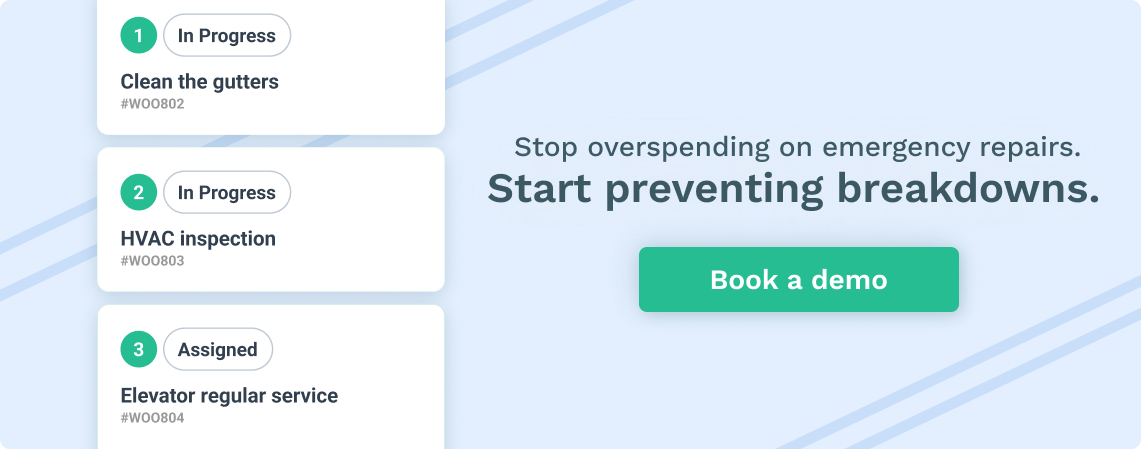
Source: WorkTrek
Implementing a CMMS software system can give facility managers a centralized tool to track KPIs efficiently. As a maintenance manager, you can have a single dashboard and extensive reporting options to track KPI progress.
Equipped with robust solutions such as maintenance management software, facility managers can monitor KPIs meticulously and effortlessly, transitioning from cumbersome spreadsheets to dynamic dashboards offering real-time insights.
By setting benchmarks and consistently observing factors like downtime, facility managers can gauge advancements made within their processes, optimize their strategies for managing resources effectively, and recognize achievements stemming from enhanced efficiency through diligent work by their respective maintenance teams.
The Impact of Preventive Maintenance on KPIs
In facilities management, the maxim that prevention is better than a cure rings exceptionally accurate.
A robust preventive maintenance strategy and schedule do more than prevent breakdowns—they align with overarching maintenance goals and enhance operational efficiency. Consistent execution of scheduled maintenance tasks ensures operations proceed without interruption, guaranteeing regular equipment availability for ongoing productivity.
Preventive maintenance isn’t simply about completing a checklist. It involves carefully executing tasks such as lubrication and calibration to increase the machinery’s lifespan and dependability.
Tools for predictive analytics can act as a crystal ball within facilities management, providing advanced warning of potential malfunctions to facilitate seamless system operation.
Financial considerations are paramount, with metrics like Return on Preventive Maintenance Investment (ROMI) showcasing the cost benefits and aiding in prudent budget management. Compliance with preventive maintenance protocols also enhances both the performance and longevity of an organization’s assets.
Maximizing Asset Lifecycle Through KPI Monitoring
The effectiveness of the maintenance strategies in place is reflected by how long an asset lasts. By tracking key performance indicators (KPIs) like Mean Time Between Failures (MTBF), facility management can make strategic choices that prolong the asset’s service life and boost its dependability.
A longer MTBF indicates robust and durable machinery and predicts a time when equipment function can be reliably predicted and improved.
On another note, successful machine upkeep isn’t solely about hardware but also the teams and procedures that maintain them. Monitoring the maintenance backlog as a KPI ensures there are enough hands on deck to address maintenance needs promptly, which helps circumvent work order postponements and unforeseen repair emergencies.
Ignoring these critical KPIs could precipitate numerous issues, including understaffing or adopting a reactive approach to repairs instead of proactively managing tasks.
Both scenarios may negatively impact effective work scheduling and compromise asset durability.
Strategies to Reduce Reactive Maintenance
Transitioning from unplanned maintenance to a preventive approach is like moving from being an emergency responder to implementing fire prevention strategies.
Being overly dependent on reactive maintenance can deplete resources and affect technicians’ morale.
By achieving a better balance between proactive and reactive elements within maintenance strategies, facilities can create an environment that anticipates potential equipment issues before they occur, thereby prolonging asset longevity.
Initiating a regular schedule for inspecting vital machinery constitutes the initial phase in transitioning toward seamless operations with fewer interruptions. Progression from a primarily reactive framework to one that emphasizes proactive methods involves consistently reevaluating current procedures and instituting preventative care plans consistent with recommendations provided by equipment manufacturers.
For any preventive maintenance strategy to be effective, it must embrace ongoing oversight and enhancement as its core principles.
In doing so, problems are addressed, and future malfunctions are thwarted beforehand—thereby establishing predictive practices at the heart of any advanced maintenance agenda focused on elevating availability while curbing service disruptions.
KPI-Driven Inventory Management
Incorporating key performance indicators (KPIs) into this process allows enterprises to monitor their effectiveness, pinpoint areas for enhancement, and refine their strategies to manage stock levels.
Achieving equilibrium by meeting work orders while avoiding overstock is essential for preserving operational nimbleness and economic solidity.
Indicators such as spare parts turnover rate and overall inventory turnover ratio gauge how quickly items cycle through a system.
This measure can show an organization’s management efficiency regarding its inventory costs. Yet, it’s not solely about the flow of goods.
There are cost implications, too. The total carrying cost of one’s stock includes expenses related to:
- Warehousing
- Depreciation due to obsolescence
- Insurance premiums
- Handling charges
- Opportunity costs associated with capital investments
These expenditures play an essential role in shaping strategy around streamlining inventories effectively. Companies can aspire toward finely tuned, agile practices in managing their inventorial assets by adopting methods like just-in-time delivery systems and accuracy-driven reordering protocols based on solid data analysis.
Role of Technology in Tracking Facilities Management KPIs

Source: WorkTrek
In today’s digitally evolved landscape, integrating technology is essential for proficiently monitoring key performance indicators (KPIs) in facilities management.
Maintenance management software has transformed how maintenance teams manage and interpret data by providing an organized system for choosing and overseeing metrics.
Specifically, CMMS (Computerized Maintenance Management System) software is a pivotal point for KPI oversight, enhancing the simplicity and depth of analysis.
Transitioning from traditional manual methods such as spreadsheets to advanced CMMS platforms has not merely made managing data more efficient. It has also equipped facility managers with instantaneous insights critical to informed decision-making.
These contemporary solutions serve beyond mere storage systems—they produce comprehensive reports and dashboards that quantitatively and qualitatively reflect every facet of a facility’s performance.
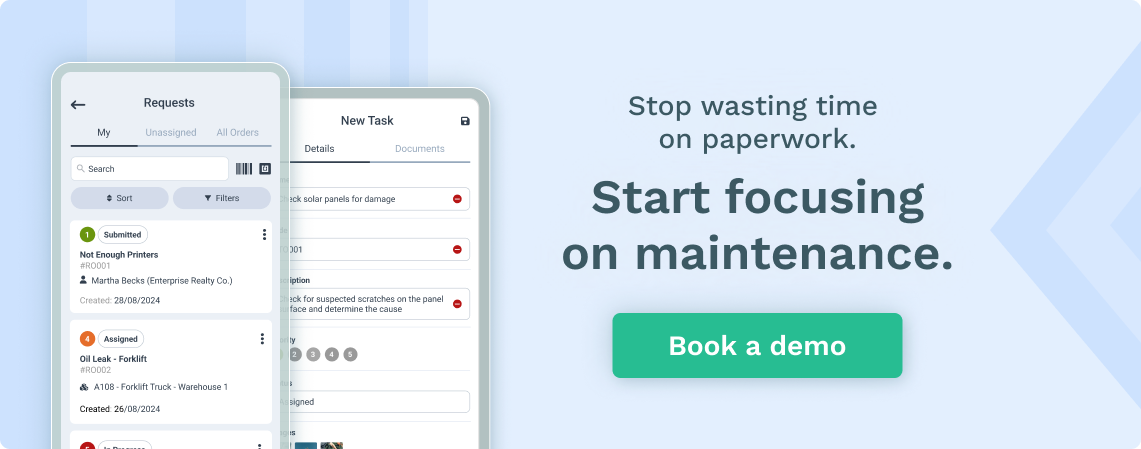
These tools ensure the automatic capture of information while maintaining its secure storage.
Leveraging KPIs for Vendor and Contractor Management
The smooth running of facilities management relies on the collaborative relationships between vendors and contractors. Tracking vendor management KPIs ensures that this machinery operates at peak efficiency, maintaining high value and low risk in supplier dynamics.
Establishing and monitoring baseline metrics holds vendors accountable and ensures they meet, if not exceed performance expectations.
Vendor KPIs act as a compass, guiding partnerships toward sustained success and allowing for adjustments that address deficiencies and reinforce positive outcomes. Metrics like supplier lead time and compliance rate are essential for this calibration, ensuring vendor performance remains at the forefront of facilities management efforts.
By aligning these KPIs with contractual terms and business objectives, facilities managers can track and rate vendors effectively, fostering relationships built on transparency and mutual benefit.
Understanding Occupant Satisfaction as a KPI
Occupant satisfaction, the human aspect of facilities management KPIs, represents the tangible impact that maintenance teams have on the inhabitants of the spaces they maintain.
It’s a measure that goes beyond the mechanical, gauging the success of creating an environment that’s functional but also comfortable and secure. By focusing on KPIs that minimize environmental stressors and expedite work order fulfillment, facility managers can enhance the quality of life within their buildings.
Pursuing high customer satisfaction rates is not just about appeasing clients—it’s about understanding their experiences and interactions within the facility. These KPIs are a powerful tool for optimizing occupant experience, ensuring that the space meets and exceeds their expectations, and creating a harmonious blend of functionality and comfort.
KPI Case Studies: Success Stories in Facilities Management
The transformative power of KPIs in facilities management is best displayed through success stories illustrating their real-world impact. Here are some examples:
- The George Centre used FMI Works to maintain asset visibility and ensure regulatory compliance.
- The Malaghan Institute of Medical Research also leveraged FMI Works for efficient facilities management.
- NATA deliberately evaluated and selected facilities management software to improve their management processes.
These success stories highlight the significance of choosing the right tools for efficient facilities management.
From entertainment operators centralizing their facilities management to aged care providers moving to the cloud, the case studies demonstrate how better data management and progressive processes elevate compliance and reporting capabilities within facilities management.
Summary
Understanding the ins and outs of facilities management can be tricky, but KPIs make it easier. They act like a reliable guide, helping you keep everything running smoothly. From ensuring your equipment is always up and running to keeping everyone happy, KPIs light the way to doing a great job.
As we have seen, these metrics are not just about maintenance; they are about shaping a facility that thrives through efficiency, sustainability, and satisfaction. Embrace these insights and let the power of KPIs transform your facilities management into a benchmark for success.
Frequently Asked Questions
What’s the difference between maintenance metrics and key performance indicators (KPIs)?
To summarize, maintenance metrics deliver precise information regarding the upkeep tasks performed, while key performance indicators offer a more comprehensive view of an organization’s accomplishments in reaching its goals. Each plays a vital role. Metrics furnish intricate particulars; KPIs provide overarching insight and guidance into these activities.
How can maintenance management software improve KPI tracking?
Leveraging maintenance management software can significantly improve tracking KPIs by facilitating streamlined data gathering and analysis. This software provides automatic data capture capabilities, ensures secure information storage, and delivers real-time insights that can inform decision-making processes and enhance maintenance management activities.
Why is preventive maintenance necessary for KPIs?
Maintaining assets through preventive maintenance is crucial for key performance indicators (KPIs) as it decreases malfunctions, lessens operation interruptions, and diminishes maintenance expenditures. This positively affects both the operational effectiveness and the reliability of equipment, guaranteeing steady functionality and readiness for use.
What role does asset uptime play in facilities management?
In facilities management, equipment availability and readiness for production or service, also known as asset uptime, is a vital performance metric. Elevated levels of asset downtime indicate that a facility is making the most out of its investment in equipment while operating proficiently, which influences productivity, operational costs, and, ultimately, the operation’s financial health.
How do space utilization KPIs contribute to facility management?
Space utilization KPIs contribute to facility management by enabling strategic decision-making on space requirements, optimizing facility use, and ensuring the facility meets dynamic needs while conserving resources.
This helps managers adjust layouts, improve occupant comfort, and reduce waste.




